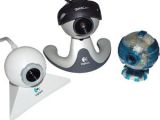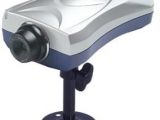Digital camcorders are cool and come in several interesting formats. But what exactly should be used when we want to broadcast streaming video content over the Internet? Sure, some digital camcorders allow you to do this and they do it flawlessly too. However, these devices may appear to be a little pricey for mainstream consumers. How about a webcam or a remote camera? Right... more than decent prices and powerful features with these ones. Let's take a closer look.
Big Brother sort of thing Webcams (web cameras) are real-time cameras whose images can be accessed using World Wide Web Internet protocols, instant messaging programs or a PC video calling application. Variants of this model include Web-accessible cameras that typically involve a digital camera which uploads images to a web server, either continuously or at regular intervals. Another variant is represented by videoconferencing cameras, which take the form of small cameras connected directly to a PC. If you have older analog cameras, you can put them to good use by connecting them to a video capture card inside the PC. This may enable the analog model to directly or indirectly broadcast over the Internet.
The beginnings of this technology date back to 1991, when the first webcam was pointed at the Trojan room coffee pot in the computer science department of Cambridge University. Though the continuous broadcasting of this very first webcam was suspended sometime in 2001, people can still watch recorded footage or even the last captured images on the university's site.
As with many new technologies, webcams and webcam video-chat found early commercial adoption and aggressive technology advancement through use by the pornography industry. The adult entertainment industry wanted easily accessable 'live' images and requested a Dutch developer to write a special software that could do this without involving annoying web browser plug-ins. This led to the birth of the 'live streaming webcam' technology, which is still available in various forms today.
As videoconferencing techniques evolved, it was soon realized that Internet users enjoyed viewing images from cameras set up all over the world. While the 'web-' prefix in webcams point out the obvious Internet connection, there also exist many remote cameras that can monitor places. These cams can still be accessed over the web but remain fixed in one place, providing views into homes, offices and other buildings as well as providing panoramic views of cities (Metrocams) and the countryside. Accordingly, one may find TraffiCams, WeatherCams and even VolcanoCams. You got something that needs to be monitored remotely? No problem... just set up a webcam somewhere around power and Internet connections.
How the 'eye of the beholder' works The webcam is basically a reduced-scale digital video camera that can attach to your computer, typically through the USB port. Webcams normally include a lens system, an image sensor, and some support electronics. Various lenses are available, but the most common is a plastic lens that can be screwed in and out to set the camera's focus. This is to be found in cheap models. Image sensors can be the usual CMOSs and CCDs. Consumer webcams usually offer a resolution in the VGA region, at a rate of around 25 frames per second. Higher resolution models, which support resolutions up to 1.3 or 2 Megapixels are a bit pricier, and you may want to check the Kinamax, Sabrent or Logitech offer if you are into these.
The supporting electronics array is included in order to read the image from the sensor and transmit it to the host computer. Some cameras that are usually integrated in mobile phones use a CMOS sensor with supporting electronics 'on die.' This is to mean that the sensor and the support electronics are built on a single silicon chip, to save space and manufacturing costs.
The web-ish nature of this device is given by the compatible special software. Webcam software "grabs a frame" from the digital camera at a preset interval (for example, the software might grab a still image from the camera once every 30 seconds) and transfers it to another location for viewing. This is better suited for reduced band connectivity over the Internet. But if you're interested in using your Webcam for streaming video, you'll eventually want to try a cam that delivers high frame rates. Frame rate indicates the number of pictures the software can grab and transfer in one second. For streaming video, you need a minimum rate of at least 15 frames per second (fps), while 30 fps is the real thing. To achieve this high fps count, you need a broadband Internet connection, which might give you some money-related issues.
The instant it captures a frame, the software automatically broadcasts the image over your Internet connection. There are several broadcasting methods. The simplest way to broadcast implies that the software can turn the captured image into a JPEG-compressed file and can upload it to a Web server via the basic File Transfer Protocol (FTP). Of course, not anyone can afford a personal Web server but lots of Internet-based companies offer you a free place to upload your images. For example, Yahoo, with its Messenger program, provides good support for these types of transfers.
This specific software is programmed to be compatible with almost every webcam. In addition, the software can be configured in many ways, and will often include options for image size and quality, overlaying logos, and image time stamping. Recent software can capture images and broadcast them over the Internet while inside computer games, allowing people to see who they're dealing with.
Many new webcams include advanced settings for power users:
* Motion sensing systems - with these, the webcam takes a new picture when it detects in-sight-motion. * Image archiving options - let users create an archive that saves all the webcam captured images or only certain images at pre-set intervals. * Video messaging - this is to be found in instant messenger programs which support Webcam video streams (Yahoo Messenger, Microsoft Live! Messenger and so on). * Advanced connectivity - allows wired and especially wireless methods to connect home-theater A/V equipment to a webcam. * Automation - advanced robotic cameras let users set a series of pan/tilt positions and program frame-capture settings based on the position of the camera. * Streaming media compression - coupled with professional applications, a webcam can use MPEG4 compression to support true streaming audio and video compatible with most of the popular PC-based media players. * Custom coding - requires some programming skills but it ultimately gives total control over the webcam.
I'm sure not many of you have a Web server already set up at home. So, what should you do if you don't want to maintain your captured images? As I've stated before, you can try many WEB-based services that offer good maintenance possibilities. A lot of webcam-related software comes complete with Web-based image access. They usually offer different access options, including remote access, which utilizes the UDP protocol to transfer your Webcam images directly from your computer to another remote computer. This can be achieved in two ways:
a) via a Web browser, in which case the software itself establishes its own type of HTTP server and anyone using a compatible Web browser can access the Webcam images on your PC. * via traditional FTP upload to a remote Web server.
By using this type of service, you avoid having to host and/or maintain your own Web site. If you are using one of these services and you want the image to refresh itself constantly, you need a higher-speed connection between your computer and the Internet. If you have a slower connection, the images won't always be up to date, due to laggy upload times.
Becoming Big Bro If remote monitoring is your thing, you can get a "network camera" that has a webcam software and a web server built right in. A camera like this doesn't need a PC at all. It only needs an Internet connection. So, if you have an Ethernet network set up inside your house, you can find a camera that could integrate with this design? However, if you want to transform a regular webcam into a remote-like one? But what's to be done if the room you want to capture is at the other end of the house, or outside? This could be an annoying problem with cameras hooked to a computer via a USB cable, which is most of the times too short. In this case, all you need to do is purchase a camera with external connections. Here are a couple of possibilities:
- A standard camera can be placed anywhere in the house and run a video cable with RCA jacks on it from the camera to the computer. The Internet is a good place to find small pinhole video cameras, either on their own or embedded in things like clocks and smoke detectors. These small security cameras can be found for less than $100.
- If cables give you a headache and ruin your cool interior design, you may want to look into radio links or Ethernet over WiFi setups.
Entertaining webcams Webcams are not used in association with PCs. Console platforms can also connect to this kind of device. In this case, you have the EyeToy compatible with the PlayStation 2, which allows players to interact with games using motion and color detection. The Xbox Live Vision Camera is compatible with the Xbox 360 console and the Xbox Live service, and can also be used for gaming applications like the EyeToy.
Apart from live communication inside the latest PC games, webcams can also be used for gaming applications using simple motion detection algorithms. Webcam games for PCs are available as either standalone executables, or they can even be played inside of a web browser window using Adobe Flash.
Monitoring your home and sharing images via the Web are the most obvious things you can do with a webcam. But this is just a small portion of the actual possibilities that derive from such devices. You can get software that will let you make video phone calls with friends who happen to have a webcam. You can hold a video-conferencing session with business associates on the other side of the world. You can prepare an interview and broadcast it live on your blog site. Some Webcam software will even deliver images directly to an Internet-connected PDA or smartphone. Other products let you connect your camcorder to your Webcam setup so you can let everybody watch your vacation footage via the Internet.

 14 DAY TRIAL //
14 DAY TRIAL // 

